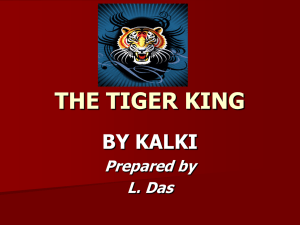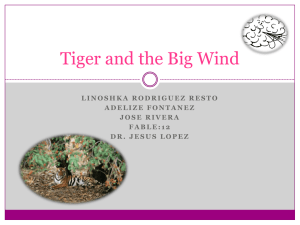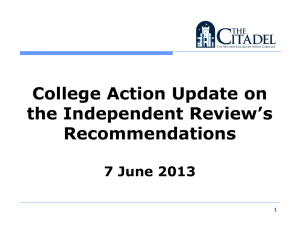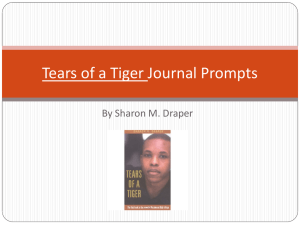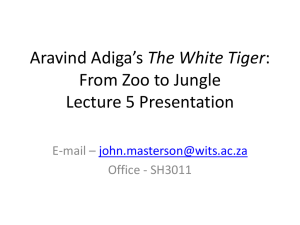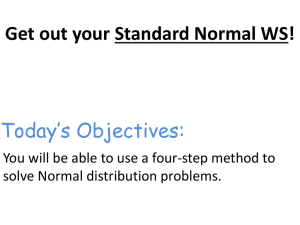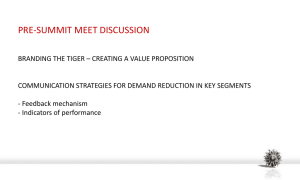ENGL1003 – Aravind Adiga`s The White Tiger – Lecture 3
advertisement
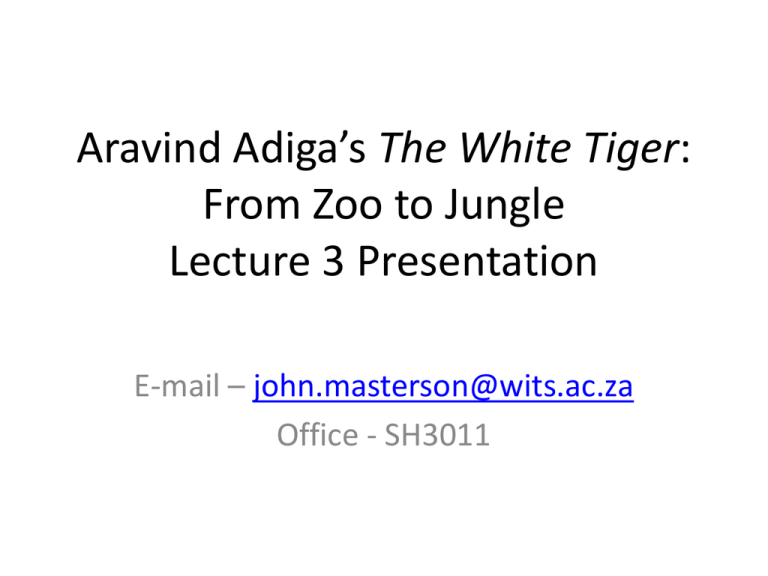
Aravind Adiga’s The White Tiger: From Zoo to Jungle Lecture 3 Presentation E-mail – john.masterson@wits.ac.za Office - SH3011 How to access these presentations •Access the English 1 Blog via the following weblink •http://witsenglishi.word press.com The White Tiger and Corruption From Religion to Politics – what/who is really being ‘attacked’? Mohandas Karamchand Gandhi The Ultimate Betrayal of Gandhi’s Legacy? Balram as Alternative Tourist Guide (pp.136-137) • I looked out the window to see a large bronze statue of a group of men – this is a well-known statue, which you will no doubt see in Delhi: at the head is Mahatma Gandhi, with his walking stick, and behind him follow the people of India, being led from darkness to light. The Mongoose squinted at the statue. ‘What about it? I’ve seen it before.’ ‘We’re driving past Gandhi, after just having given a bribe to a minister. It’s a fucking joke, isn’t it’ ... ‘Things are complicated in India, Ashok. It’s not like in America. Please reserve your judgement.’ 2009 Figures The White Tiger and Satire (p.18) • Surely you’ve heard of Bodh Gaya – the town where the Lord Buddha sat under a tree and found his enlightenment and started Buddhism, which then spread to the whole world, including China – and where is it, but right here in my home district! Just a few miles from Laxmangarh! I wonder if the Buddha walked through Laxmangarh – some people say he did. My own feeling is that he ran through it – as fast as he could – and got to the other side – and never looked back! Buddhism and Branding? Enlightenment as Industry? The Debunking Power of The White Tiger (pp.19-20) • Your Excellency, I am proud to inform you that Laxmangarh is your typical Indian village paradise, adequately supplied with electricity, running water and working telephones; and that the children of my village, raised on a nutritious diet of meat, eggs, vegetables and lentils, will be found, when examined with tape measure and scales, to match up to the minimum height and weight standards set by the United Nations and other organizations whose treaties our Prime Minister has signed and whose forums he so regularly and pompously attends. Ha! Electricity poles – defunct. Water tap – broken. Children – too lean and short for their age, and with oversized heads from which vivid eyes shine, like the guilty conscience of the government of India. The White Tiger and the question of fate. • Free will versus determinism? To what extent can novel be read as ‘celebration’ of human ingenuity? Balram’s battle against the odds … • (p.38) – “Working in a tea shop. Smashing coals. Wiping tables. Bad news for me, you say? To break the law of his land – to turn bad news into good news – is the entrepreneur’s prerogative.” Humanity and Bestiality? (p.51) • Go to a tea shop anywhere along the Ganga, sir, and look at the men working in that tea shop – men, I say, but better to call them human spiders that go crawling in between and under the tables with rags in their hands, crushed humans in crushed uniforms, sluggish, unshaven, in their thirties or forties or fifties but still ‘boys.’ But that is your fate if you do your job well – with honesty, dedication, and sincerity, the way Gandhi would have done it, no doubt. I did my job with near total dishonesty, lack of dedication, and insincerity – and so the tea shop was a profoundly enriching experience. Establishing India as duality (pp.8-9) • My country is the kind where it pays to play it both ways: the Indian entrepreneur has to be straight and crooked, mocking and believing, sly and sincere, at the same time. So: I’m closing my eyes, folding my hands in a reverent namaste, and praying to the gods to shine light on my dark story. Indication of division of critical opinion in relation to The White Tiger • Robbie B. H. Goh - • “What characterizes the narrative is the chilling frankness and simplicity with which Balram recounts his career of poverty and oppression, desperation and finally murder of his employer and theft of the fortune that sets him up in his successful business.” Amitava Kumar • “Halwai’s voice sounds like a curious mix of an American teen and a middle-aged Indian essayist. I find Adiga’s villains utterly cartoonish, like the characters in Bollywood melodrama. However, it is his presentation of ordinary people that seems not only trite but also offensive.” Chandrahas Choudhury • “What readers around the world frequently find instructive, fresh, and moving about Indian novels available to them in English, is often experienced by Indian readers as dull, clichéd, and superficial.” Why are concepts such as “the real India” and “authentic voice” so hotly contested when it comes to The White Tiger? Class mobility vs. Caste immobility? (p.56) • The old driver asked, ‘What caste are you?’ ‘Halwai.’ ‘Sweet-makers,’ the old driver said, shaking his head. ‘That’s what you people do. You make sweets. How can you learn to drive? … That’s like getting coals to make ice for you. Mastering a car’ – he moved the stick of an invisible gearbox – ‘it’s like taming a wild stallion – only a boy from the warrior castes can manage that. You need to have aggression in your blood. Muslims, Rajputs, Sikhs – they’re fighters, they can become drivers. You think sweet-makers can last long in fourth gear?’ Coal was taught to make ice, starting the next morning at six. - To what extent does The White Tiger ‘defamiliarize’ (make strange) debates around caste? The Caste System Didactic Imperatives in The White Tiger? Consider example of Caste (p.63) • I should explain a thing or two about caste … See: Halwai, my name, means ‘sweet-maker.’ That’s my caste – my destiny … But if we were Halwais, then why was my father not making sweets but pulling a rickshaw? Why did I grow up breaking coals and wiping tables, instead of eating galub jamuns and sweet pastries when and where I chose to? Why was I lean and dark and cunning, and not fat and creamyskinned and smiling, like a boy raised on sweets would be? Robbie B. Goh • Hindu life is not the only thing that Balram critiques … he also exposes the prevalent corruption and economic exploitation in his society … Hinduism and the caste system now work as a corollary to a kind of economic freefor-all, reinforcing socio-economic inequality and Darwinian survival at all cost with notions of social place and “destiny.” • Corollary = “supplementary, associated.” Consider importance of treatment of religion in opening section of novel – how does it establish what will come later? (p.8) • Now, there are some … who think that not many of these gods actually exist. Some believe that none of them exist. There’s just an ocean of darkness around us. I’m no philosopher or poet, how would I know the truth? It’s true that all these gods seem to do awfully little work – much like our politicians – and yet keep winning re-election to their golden thrones in heaven, year after year. That’s not to say that I don’t respect them, Mr Premier! The White Tiger From Zoo to Jungle The White Tiger and Naming (p.35) • The [school] inspector pointed his cane straight at me. ‘You, young man, are an intelligent, honest, vivacious fellow in this crowd of thugs and idiots. In any jungle, what is the rarest of animals – the creature that comes along only once in a generation?’ I thought about it and said: ‘The white tiger.’ ‘That’s what you are, in this jungle’ … So that’s how I became the White Tiger. There will be a fourth and a fifth name too, but that’s late in the story. Tragedy of Balram’s fate? Taken out of his hands? Variations on the Jungle Motif (p.57) • The old driver – ‘It’s not enough to drive. You’ve got to become a driver. You’ve got to get the right attitude, understand? … The road is a jungle, get it? A good driver must roar to get ahead on it.” From Zoo to Jungle … (pp.63-64) • See, this country, in its days of greatness, when it was the richest nation on earth, was like a zoo. A clean, well-kept, orderly zoo. Everyone in his place, everyone happy. Goldsmiths here. Cowherds there. Landlords there … And then, thanks to all those politicians in Delhi, on the fifteenth of August, 1947 – the day the British left – the cages had been let open; and the animals had attacked and ripped each other apart and jungle law replaced zoo law. Those that were the most ferocious, the hungriest, had eaten everyone else up, and grown big bellies. That was all that counted now, the size of your belly … To sum up – in the old days there were one thousand castes and destinies in India. These days, there are just two castes: Men with Big Bellies, and Men with Small Bellies. And only two destinies: eat – or get eaten up. The White Tiger (p.275) • Now, Mr Premier, every day thousands of foreigners fly into my country for enlightenment. They go to the Himalayas, or to Benaras, or to Bodh Gaya. They get into weird poses of yoga, smoke hashish, shag a sadhu or two, and think they’re getting enlightened. Ha! If it is enlightenment you have come to India for, you people, forget the Ganga – forget the ashrams – go straight to the National Zoo in the heart of New Delhi. White Tigers in New Delhi’s National Zoo The Ganges River India as duality cont. (p.14) • I am talking of a place in India, at least a third of the country, a fertile place, full of rice fields and wheat fields and ponds in the middle of those fields choked with lotuses and water lilies, and water buffaloes wading through the ponds and chewing on the lotuses and lilies. Those who live in this place call it the Darkness. Please understand, Your Excellency, that India is two countries in one: an India of light, and an India of Darkness. The ocean brings light to my country. Every place on the map of India near the ocean is well-off. But the river brings darkness to India – the black river. The Ganges River Near the Ganges River Key areas to be discussed in forthcoming sessions Representations of Space in The White Tiger Representations of the Body in The White Tiger Ecological/environmental concerns in The White Tiger How and why do the above work in relation to one another?

